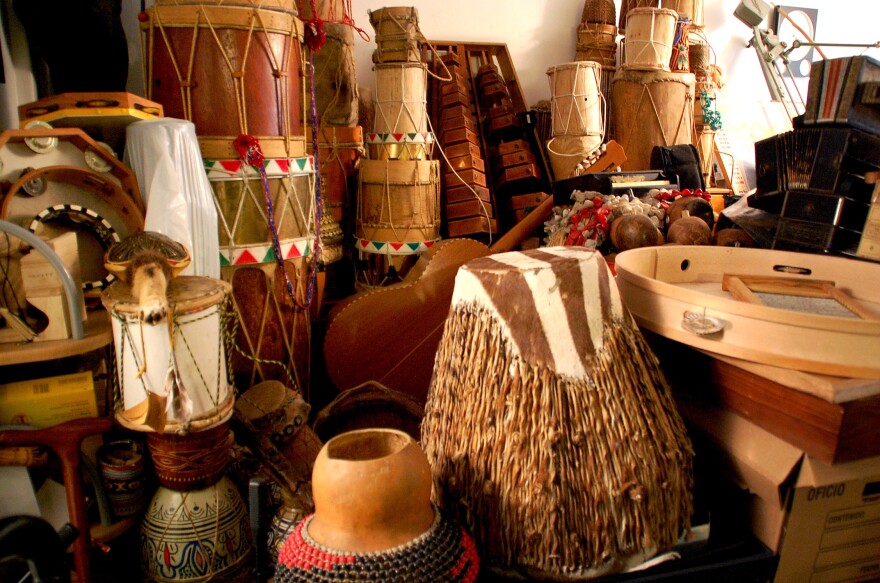There's a place in Mexico City that's filled with thousands of musical instruments from all over Latin America — some of them more than 100 years old. It's not a museum or music school. It's an apartment. Actually, the collection's grown so much, it now fills two apartments. It's the result of a lifelong passion for the instruments and their history, as well as a determination to share them.
Guillermo Contreras is a brawny 63-year-old with gray hair and a beard, wearing blue jeans and a black dress shirt, but when he opens the door, you barely notice him. There are instruments everywhere. It's more than any museum collection I've ever seen.
"No, I've filled one museum with 300 pieces," Contreras says. "I can tell you, there are more than 4,000 instruments here."
He's got Jaranas, vihuelas, guitarrones, bajo quintos — all Mexican offspring of the Spanish guitar, which was brought here during the colonial period. There are also violins and harps of every size, marimbas, dozens of percussion instruments, and wind instruments of every shape, length and sound.
He pulls out a reed flute and says it was played by the Aztecs. The instrument is still played in a region of northeastern Mexico.
Contreras was an architect by profession when he traveled to a small town south of Mexico City in the late 1960s. He met a group of old musicians, some born in the late 1800s, who were playing instruments from that period.
"They thought it was amusing that a guy from the city would visit them and have so much interest in their music, which was sort of dying," Contreras says. "Many of them wanted to give me their 10-string guitars, and I couldn't take that away from the family."
A few months later, he went back and found that some of the musicians had died. He asked their families about the centuries-old instruments — and says he was stunned by what he heard.
"An instrument from the 19th century, already destroyed, had been turned into a chicken feeder; another one became a little kid's wooden horse."
Contreras decided then and there that he would dedicate his life to documenting and preserving his country's musical heritage.
Contreras is not just an instrument collector. He also knows each instrument's individual history and how to play it. He pulls out a guitarra séptima, a 14-string guitar that was widely played across Mexico in the 19th century. Next, he demonstrates how to play a five-string guitarra de golpe, a strumming guitar still played in the state of Guerrero.
Contreras walks the walk, says Graco Posadas, director of programming at the CENART, the National Center of the Arts in Mexico City.
"Every time you ask him about the music," Posadas says, "he'll tell you he's already been to the mountains, he's already walked the kilometers, and he's the only one that's dedicated time to preserve those instruments, some of which have disappeared, unless he has them, and from every region in Mexico."
In addition to the instruments, Guillermo Contreras has also amassed a large collection of field recordings, old photos and music publications dating back hundreds of years. He spends 16 hours a week sharing what he knows.

In a small classroom at the National School of Music, three students tap small turtle-shell drums with deer horns as Contreras plays a small bamboo flute. It's the same melody that's been played by Zapotec people of Oaxaca for hundreds of years. One of the students is Dalila Franco. She's been studying music with Contreras for about a year.
"These rhythms, these melodic patterns, are calling us Mexicans; they're telling us who we are, even if we don't understand what they're trying to tell us," Franco says. "So the School of Music offers two tracks: the Western approach we inherited from Europe, where we learn the music of Beethoven, Mozart and Bach. But there's also this other one that has a lot to do with our identity."
For more than four decades, Guillermo Contreras has been a mentor and teacher to dozens of young musicians. He's tried to get funding to build a museum and a music school, without success. But he keeps collecting and teaching because, he says, these instruments and their history are precious reminders of our humanity.
"I feel that this helps me understand a little bit more about life, as seen through the art of music and the musical instrument, which I believe are the most precious creations of humanity."
With or without a museum, Contreras says that's reason enough to continue collecting them, though he says he's a little worried about finding space for more.
Copyright 2022 NPR. To see more, visit https://www.npr.org.




